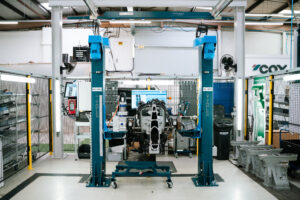Yacht owners warned against under-insuring

Spotting a new trend, Andy Postle, MD and founder of the mast and rigging company Allspars, says his company has been losing some of its replacement mast quotes. Not many, given the quality and reputation of the company’s work, but enough to make Postle sit up and take notice of the trend. And it’s one that he says is not good for his business, for boat owners or for the environment. Postle’s noticed that some owners are significantly under-insuring their boats, borne out of a combination of wilful naivety, economics and buying insurance online rather than a person to person discussion.
“Too many people are buying a boat for say, £2,000 and then insuring it, via the net, for what they paid,” says Postle. “But if the rigging fails, it’s potentially going to cost a lot more than the whole boat to be repaired.”
While he recognises that the “flipside is that it is difficult to get insurance on a boat for more than what was paid,” he believes people should be telling insurers the market value of the boat they’re buying and not what they paid – especially if it was a bargain.
“Everyone wants to be as cost effective as possible but they don’t think about the disparities,” Postle says. “And, generally it’s the lower value boats that experience this problem.
“If you have £100,000 invested in a yacht you generally take a lot of care over what you’ve invested. If it’s cost £100,000-plus, you insure for £100,000-plus, and then if you have to make a claim in the £20,000 range, it’s not normally a problem.
“The growing issue exists on sub- £20,000 boats – something like a Sadler 25. It might be worth £10,000- £12,000, or be a tatty one for £3,000 to £4,000. Then the owner does lots of work and gets it looking mint. But if the rig falls over to one side, the quote to replace the mast and boom will cost more than the boat’s insured for.”
Postle is keen that owners understand what they’ll need to buy if something goes wrong.
“It’s never just the price of the mast,” he says. “It’s standing rigging, the boom, halyards, electronics and nav lights, the logistics such as carriage, craning, labour and then suddenly a mast that costs £2,000 becomes £6,000 when everything’s added in.”
What happens then, says Postle, is that the repairable boats are being written off as scrap as they don’t have enough insurance in place to make the necessary repairs.
“It’s so easy to get it wrong in the little ones, in the sub-£10,000 range,” he says. “Owners possibly choose to be naive and live in ignorant bliss. They think ‘I’ve managed to insure for £100 per year’ rather than insure their boat properly.
“It’s not really a new problem, or new people coming into boating, but it’s growing. It’s possibly the desire to run boats on a budget, thinking insurers will simply pay out, but then owners get caught out.
“They end up taking the cash value, and then buy a new ‘old boat’, and it continues.”
Postle believes it’s time insurance companies include ‘rig value’ in their enquiry forms as a way of making owners think about what they’re doing. “But some insurance companies choose not to ask,” he says. “It’s possibly indicative of how things get lost in translation with everything trying to happen online.”
Postle believes that the industry is currently in the process of rebalancing itself. The last ten to 15 years haven’t seen the 30-40 year old sailors coming in at bottom end and working their way up. But he now believes lockdown has inspired younger people to invest. Postle says there’s a lot of choice, with 40-year-old boats, sub 25-foot, which are pretty worthless, a couple of hundred pounds, but that can carry on forever.
It’s these new, younger owners who will help rebalance the industry.
“We’re getting more and more enquiries to insure older boats,” says Mike Wimbridge, managing director, Pantaenius UK Limited. Wimbridge is aware that not all companies will cover them as the “yacht/pleasure boat insurance market took a massive hit in 2017 after three hurricanes in the USA which had a follow-on for everyone else,” but says that Pantaenius is focusing on ‘local heroes’ this year, and looking after them.
He agrees with Postle that “aggregator sites like GoCompare are not the norm for yachting. If sites output very low prices, clients may accept them irrespective of what those policies cover or, perhaps more importantly, what they don’t cover” and says that it is his traditional background which has informed Pantaenius’ model.
“I come from a traditional background where talking to people matters. Owners need to understand what they’re buying, and make an informed choice. It’s unfair to make an assumption that people will always want cheap, cheap, cheap,” Wimbridge continues.
The challenge of underestimating costs isn’t, however, restricted to the lower-end of the market. “We cover vessels from the ground upwards, to the biggest in the market,” Wimbridge says.
“Traditionally the rough rule of thumb for the cost of running a boat was 10 per cent of a boat’s cost. Where people are buying 30-40m older superyachts, for as little as £1m that changes and amounts to a considerably high percentage of the boat’s purchase price.
“Clients are getting these boats at a good price but it’s definitely worth talking to someone to understand the likely costs of running a boat – whatever the size.”
This article was originally published in MIN’s SIBS special edition, Sept 2021.










